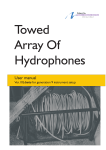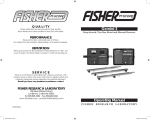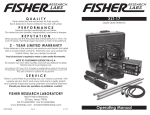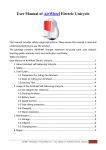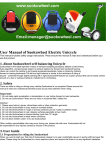Download Fisher XLT-30 User's Manual
Transcript
XLT-30 Acoustical Leak Detector Operating Manual FISHER RESEARCH LABORATORY CONTENTS Introduction ........................................................................... pg. 1 Instrument Set ....................................................................... pg. 2 Faceplate & Control Panel ................................................. pg. 4 Operating Instructions ........................................................ pg. 6 Specifications......................................................................... pg. 8 INTRODUCTION Fisher Research Laboratory has always been a leader in the field of acoustical leak detection. From the early LT-10 through the XLT-20, high quality sound amplification has been synonymous with the name Fisher. Fishers XLT-30 takes leak detection to a new level. Ultra sensitive sound microphones, combined with a non-distortion amplification system and crystal clear audio headphones make the XLT-30 the leak detector destined to set new standards for the leak professional. 1 1 INSTRUMENT SET 1. Control Box All listening and filtering controls for the XLT-30 are contained in this sturdy housing. The function of each control is described in the section entitled “Faceplate and Controls”. 2. Big Foot Probe Also known as the Ground Microphone, this probe is to be used on hard surfaces, concrete, asphalt, tile, etc. A flexible rubber shield helps prevent outside sounds from interfering with the sounds from the buried pipe. Depressing the red button near the handle will Mute the audio from the probe to suppress loud sounds when the probe is moved. 3. Hydrophonic Cylinder Probe This probe is a direct contact probe designed to make direct connection to the pipe, or any portion of the pipe that is accessible. Used in any combination of Sound Rods with the T-Handle, pipes can be accessed to distances up to nearly 6 feet away. Another feature of the Cylinder Probe is the ability to listen to pipe noise in pipes that are buried in turf, or soft surfaces. Accurate pipe location is essential for the placement of the Ground Rods as close to the pipe as possible. 2 INSTRUMENT SET On top of the Cylinder Probe is a three position toggle switch for Mute, Listen, and Momentary Listen. As with all Mute controls, learn to use them wisely. When tightening the sounds rods to the Hydrophonic Probe, secure the connector with a wrench as to not let it twist. Twisting of that connector could damage wiring on the inside of the probe. 4. Sound Rods Two different sizes are included with the XLT-30. One (1) 4 inch rod and three (3) 24 inch rods give the user various lengths for direct or indirect contact to pipes. 5. T-Handle This handle is used primarily with the Cylinder Probe and the sound rods. 6. Headphones These headphones are designed to deliver the clearest sound with the least distortion. Unplugging the headphones will turn off the XLT-30. When the XLT-30 is turned Off, any modifications to Volume, Notch, and Filter will return to the factory presets. 7. Probe Cable This cable attaches at the back of the Control Housing to any of the various probes. Make sure the jack is fully inserted and the lock nut is hand tightend. 8. Carrying Case Each unit comes with a strong plastic carrying case with foam compartments to store all parts of the XLT-30. 9. Carrying Strap/Housing Mounting Bracket The attachment system for the XLT-30 consists of a plastic mounting bracket that slides from the bottom of the control housing up to the bezel around the faceplate. There are two slots for attaching an adjustable strap that hangs around the neck of the user. 10. Little Foot Assembly (Accessory) About the size of a computer mouse, this small handheld probe designed for areas that the Big Foot Probe can not fit into. The Little Foot assembly is normally used for leak detection inside buildings. Mute is activated by depressing button in front of Little Foot Assembly. 3 CONTROL PANEL POWER This pad turns the XLT-30 On or Off. When the instrument is turned Off, all settings, or modifications to settings default to the preset factory settings. LIGHT Depress pad to turn the back light On or Off. Prolonged use of the Back Light will have minimal effect on the battery life of the XLT-30. VOLUME Depress pad to modify the Volume of the XLT-30. The arrow keys (Up arrow/Down arrow) increase or decrease the Volume to the headphones. NOTCH This control allows the user to mask or reject a small range of frequency response. Its purpose is to eliminate a sound (i. e. motor, humming, fans, etc.) that may be interfering with the leak sound. The Notch setting can be moved with the Arrow Keys. FILTER The XLT-30 has four different filtering modes. AL (All Frequencies) – This is the No Filter feature of the XLT-30. No modifications to the signal can be made with the Arrow Keys. Frequency range of the All Frequency setting is from 60 Hz to 6 kHz. 4 CONTROL PANEL (The following filter modes have a frequency range from 60 Hz to 2.4 kHz) HI (High Range) – This filtering mode allows the user to adjust the response in the higher areas of the frequency range. Use the Arrow keys to increase or decrease this frequency response range. LO (Low Range) – Similar to the previous filter mode, the Low Pass filter allows the user to listen to the lower areas of the frequency range. The Arrow keys are used to increase or decrease this frequency response range. FC (Frequency Choice) – This filter could also be called Frequency Select. This mode allows tuning to the frequency that gives the user the best response. The Arrow keys are used to move the cursor, selecting a narrow frequency band of choice HOLD/MUTE This dual purpose button is both a Mute control and a Peak Hold Reset control. Mute – As the name applies, muting disengages the sound to the user. There is also a control on all listening microphones. Learn to use this control to prevent excessive noise to your ears when the probes are moved. Hold – The display of the XLT-30 will show the highest sound level recorded. This reading can be reset by depressing this pad. Resetting the Peak Hold clears earlier readings of the Peak sound. Arrow Keys These keys allow features of the XLT-30 to be modified. RESUME After any modification has been made to the XLT-30 (VOLUME, NOTCH, or FILTER), depressing the RESUME will return the display screen back to a Meter function (Sound Graph). 5 OPERATING INSTRUCTIONS Set Up 1. Assemble Control Housing, Headset, and your choice of listening probe . The headset must be plugged in for the XLT-30 to operate. 2. Depress POWER pad to turn On the XLT-30. The XLT-30 goes through a five second warm up before the touch pads are functional. During this time, the Display Screen gives information of Battery Level. A reading of 68 or below will activate the “Low Battery” indicator. The XLT-30 does have a usage buffer between the “Low Battery” indicator and complete system shut down to allow you to complete a job. 3. The XLT-30 always turns On to the default settings. Volume is at the Medium setting, Filter is in the All Pass (no filter) mode, and the Notch Control is at the Midway point. The display screen will show the sound intensity in a bar graph form (Sound Graph) and two digit display. 4. Familiarize yourself where the Mute Buttons (and pad) are. Remember to Mute the XLT-30 when moving any probe. 5. Depress the VOLUME pad to modify headset volume. Use the ARROW pads to increase or decrease the volume. The display screen will show the volume level in a graph form. Depress the RESUME pad to exit Volume modification and return the Display Screen to the Sound Graph function. 6. Begin your leak detection search. Modifications During Leak Search Some leaks are small in size, and unrecognizable, or conditions are such that very little leak sound can be recognized, so you may need to make changes to the Filter(s) in order to hear leaks. Depending upon the type of pipe composition and soil (ground) type, different filter settings will increase your ability to hear the leak sound. Adjustment to the Filter is done by depressing the FILTER pad which will allow you to scroll through four different filter types. Frequency range modifications can be made to the HI, LO, and FC filters. As you are choosing your filter, the display screen will give a visual display of the filter type being used, and the frequency range of that filter. After your selection and modification is made, depress the RESUME pad to return to the Sound Graph function of the display screen. 6 OPERATING INSTRUCTIONS Use of the Notch Filter Occasionally, you may come across a sound that may be masking or covering your ability to adequately hear any leaks. This may be caused by nearby motors, fans, or many other annoyances. (Unfortunately, the most common are sounds caused by automobiles and traffic). The XLT-30 has a Notch, or reject feature, that will assist in eliminating that sound from your frequency range. Depress the NOTCH pad, and use the ARROW pads to move the cursor to the point where the annoying sound is eliminated or at its weakest. Depress the RESUME pad to set the Notch function. (Hint: Depress the FILTER pad to go directly to the FILTER mode. Now you can choose the type of Filter you wish to use AND still have the annoying sound Notched). 7 SPECIFICATIONS Subject to improvement or modification without notice. Operating frequency Range All pass mode 60Hz - 6kHz Filter mode 60Hz - 2.4kHz Filter Types: Independent notch filter Lowpass, Highpass or Bandpass Gain 95dB Output Indications: Audio High performance headphones (64 ohms) Visual LCD bargraph and 2-digit numeric display Battery Test Automatic Battery Type Two 9 Volt alkaline Battery Life 50 Hours (approximate) Weight Housing 1.2 lbs. Bigfoot Sensor 4.5 lbs. Case Dimensions 8-1/4" x 8-1/2" x 32-1/2" ACCESSORIES Standard Equipment: Hard Carrying Case Operation Manual Optional Equipment: Little Foot Assembly Fisher Research Laboratory does not warrant suitability to specific use. Fisher Research Laboratory shall in no event be liable for any direct, incidental, consequential or indirect damages. 8 QUALITY Fisher detectors are renowned for their quality. Each detector is hand crafted in the USA with pride PERFORMANCE The worldwide underground utility industry relys on Fisher. Our instruments are durable, dependable, and search deeper.. REPUTATION Fisher produced the first patented metal detector in 1931. For over 70 years, the Fisher logo has been a mark of excellence. 2 YEAR W A R R A N T Y Fisher believes in the products we produce and backs this belief with a 2 year warranty on all of our industrial instruments. Warranty may vary outside of the United States. See your dealer for details SERVICE Fisher is committed to providing you, our valued customer, with superior service. Each and every instrument is rigidly tested and carefully inspected during assembly and before shipment. Should you have any questions or problems, contact: FISHER RESEARCH LABORATORY 200 West Willmott Road., Los Banos, California 93635 Tel 209.826.3292 Fax 209.826.0416 www.fisherlab.com email: [email protected] for a dealer near you 1.800.M-SCOPE.1 1.800.672.6731 FRL#8700721












